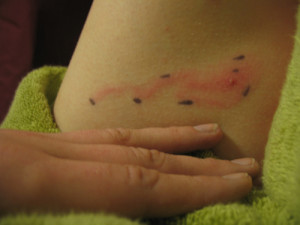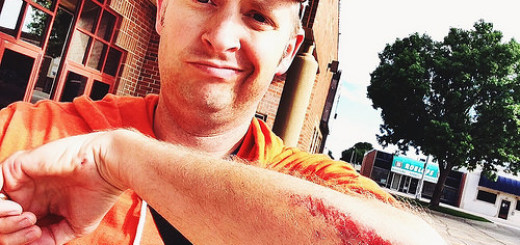Does this look infected?

Before becoming a doctor, I never knew so many people walked around every day wondering if some part of their body was infected. Ever since medical school, my family, friends, and (sometimes) strangers alike seem to want to show me their random, often disturbing body parts, and want to know if they have an infection. Once a stranger in an elevator tore off his shirt to show me his recent surgical incision.
More concerning than my inquisitive, hypochondriac friends are the patients who come to the emergency department with a foot that has clearly been brewing an infection for months: a foot that smells worse than a garbage bag full of feces and fish heads; a foot that has turned green and yellow with a thick, foul pus oozing from between the toes; a foot so terribly infected through skin, tissues, and bones that the only cure is amputation. You get it right? It gets gross. The crazy part: this actually happens. Patients don’t realize they have an infection, then they try to wait out the infection to see if it gets better, they then try home remedies (e.g.-semen and bleach, what should I put on my scrapes), and before it is too late, they need an amputation. So how do you know if something is infected far beyond the point of no return?
This response is your body trying to fight off the infection. The area will become warm and sometimes it will even feel downright hot. The area will turn red or darken. The area may swell or even blister as blood vessels in the affected area become “leaky.” The area may start to hurt.
Since early signs are just generic signs of inflammation, an allergic reaction and early infection can often be difficult to distinguish.
Infections can itch as well, but allergies usually release more of the body cell types (called mast cells) that make you itch. Allergic reactions happen as a result of an exposure to something your body considers a foreign threat– a bug bite, a new detergent, a recent hike, etc. However, most people are exposed to an offending agent without realizing what it is. Infections can occur randomly, but they are more likely to occur than an allergic reaction if you have a recent wound, cut, surgical incision, or any break in the skin that could introduce bacteria. Many patients believe they have “bug bites” when they actually have either an allergic reaction to the bite, or an infection introduced by the bug through dirty skin. Allergic reactions should improve with antihistamine medications, such as diphenhydramine (Benadryl), loratadine (Claritin), cetirizine (Zyrtec), etc. There is little downside to trying a dose of antihistamine to see if symptoms improve or resolve.
As infection spreads, the signs will become more obvious.
As bacteria and cells meant to kill bacteria collect under the skin, the product of their ongoing battle is pus. While general inflammation may leak some clear fluid, pus from an infection smells gross, and thick white or yellow or green (imagine popping a pimple). As the infection grows deeper in the tissue, it kills off the blood supply to skin and the skin may start to darken further and can become dusky and dark. Pain will get worse in general, until the infection kills all the nerve fibers under the skin, at which point there may not be anymore pain. Once the infection gets into the blood stream the body will start to have a systemic response to the infection: fevers, chills, nausea, vomiting, feeling weak, breathing fast, or a fast heart rate can all be seen. Severe pain or air bubbles under the skin are very bad signs, and these signs can be early indicators of a “flesh-eating bacteria.” This type of infection has become so deeply buried under the tissue that none of the other signs of infection (redness, warmth, swelling, pus) will be seen until it is too late.
Hopefully, you will have received medical attention at the early signs of an infection, as all skin/tissue infections will require either antibiotics and/or drainage (if there is a collection of pus called an abscess/”boil”). In the event that you have a cut or spot on your skin that is only slightly red but has no other signs of infection, the best thing to do would be to use a pen or marker to outline the area and check on it in a few hours to see if it is getting worse. If worsening, seek medical attention. If it stays the same and does not develop any of the other signs of infection, you can probably try to wait to ask the next doctor you meet on an elevator.
photo credit: Lo gracioso es el contraste con el otro via photopin (license)
photo credit: spider bite via photopin (license)




Your Thoughts